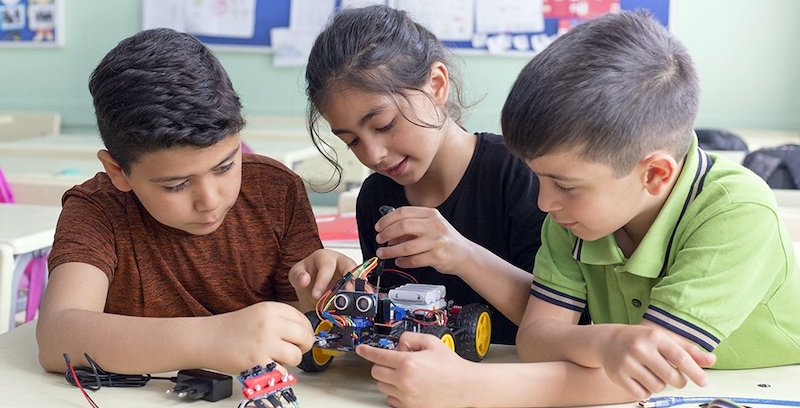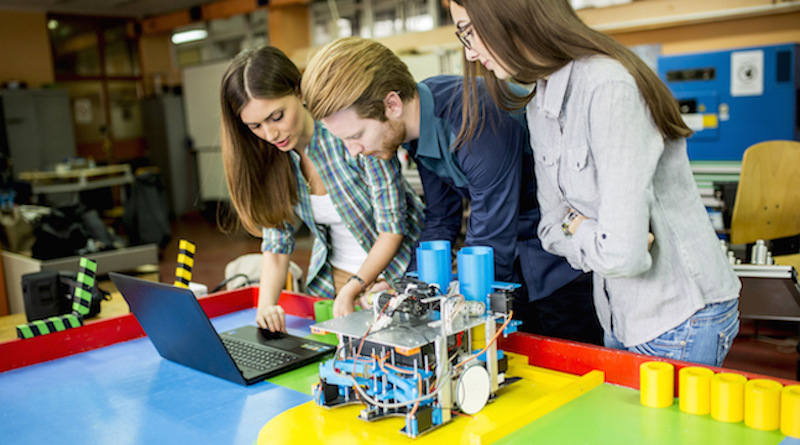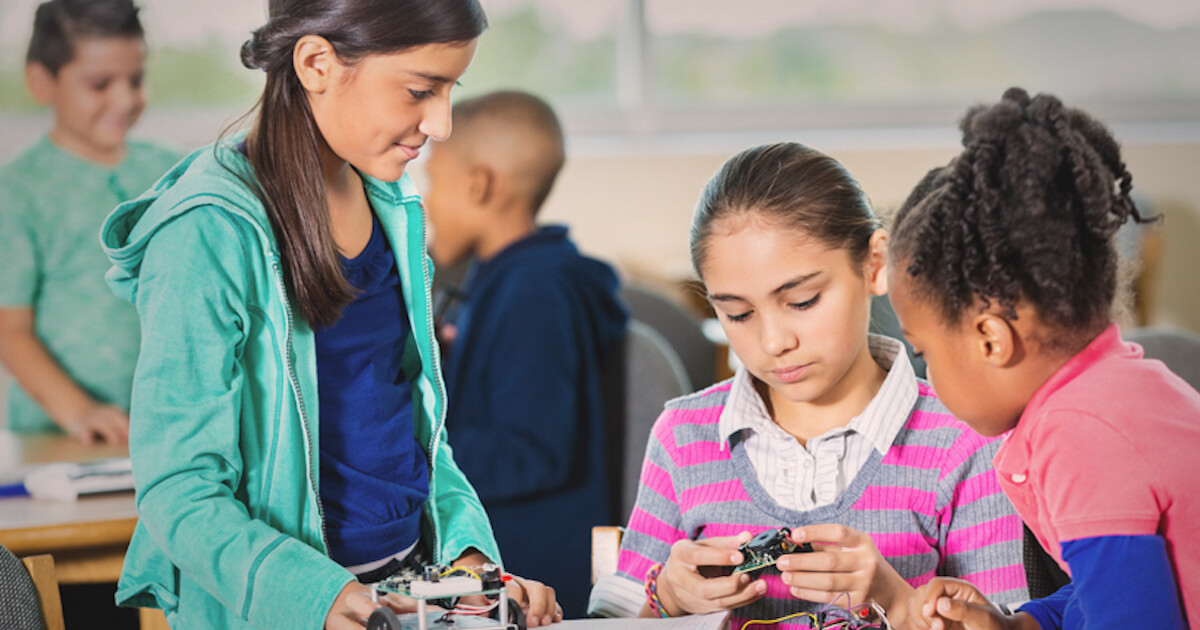Creating an ideal education experience for today’s diverse students can be intimidating or even demanding on educators. Even with extensive research, data, and firsthand observations, it's sometimes impossible to pinpoint the exact recipe for optimizing learning conditions. Today's educators, as we know, deal with lots of new challenges within their instruction and beyond, including with how to best expose these students to STEM learning. STEM education remains a huge part of the economy and, consequently, it's a large focus in many classrooms but that does not always make it easy for educators to ensure that these opportunities are accessible, equitable, and effective for all students.
Combatting Challenges with Girls in STEM
One of the most noticeable discrepancies in STEM education has to do with gender among STEM majors and professionals. STEM is noticeably male-dominant—a problem that many educational leaders, parents, politicians, and students themselves are actively trying to fix. As we aim to shrink the gender gap in STEM, it’s important to know when this gap emerges. Research shows that girls (and even boys) can lose interest in STEM in the early grades—usually by third grade. With this lack of interest also comes less motivation to participate in STEM and, ultimately, less inclination to pursue STEM. However, some good news is that the number of women in STEM is increasing, but we still need active commitment so it keeps trending up.
A STEM education for girls.
Though the gender gap in STEM is closing, education leaders must focus on keeping it from reappearing. These include efforts to establish partnerships with leaders from various organizations who are committed to sharing experiences, expertise, and resources that help educators and parents inspire and inform young girls. In STEM, girls often benefit from opportunities that are designed specifically for them—those that set them up for success in an inclusive, intimidation-free environment. Feeling like they must power through an intimidating experience because it will benefit them long-term isn't what we want happening. Plus, it could lead to them shying away from this type of atmosphere and STEM in general.
Creating STEM programs for girls.
One way to combat a lack of women in STEM is to simply create more programs for young girls. This won’t always work, though, so education leaders might need to focus on keeping commitment levels high. There are various factors surrounding girls shying away from STEM, too, including demanding careers potentially impacting their family, for example. Sure, STEM careers are challenging and often require a lot of hours but we hope that women with the drive and intellectual ability feel like they would be welcomed into the STEM workforce. Though the challenges are complex and may evolve, making sure girls know they're welcome in STEM is a solid start.
Using STEM to Help Students with Challenges
Despite challenges in perfecting how to teach STEM subjects, these experiences can help kids overcome many challenges they might face in the future. Exposure to STEM learning and STEM concepts could help them develop the right skill sets and mindsets to use what they've learned when they’re solving problems. Also, one of the most advantageous ways that STEAM education can help students is with early exposure. Research shows that elementary STEM education helps combat that lack of interest students sometimes have in pursuing STEM. Basically, the earlier that STEM, its elements, and its benefits are a regular aspect of students’ lives, the better.
How educators approach STEM instruction.
There are certainly cross-curricular connections in STEM education and this allows educators to weave it into learning in multiple ways. Teachers won't have to limit STEM approaches and content to their science class, for example. With an approach like this, they could help students develop the proper mindset to take on STEM challenges and solve problems across all subjects. This can also help students learn at their own pace and helps teachers customize lesson plans to accommodate that. With STEAM elements appearing in various classes, students should soon start to develop the necessary mindset and build on the problem-solving approaches they’ve already learned, carrying these benefits over from year to year.
Relating STEM education to real-world challenges.
In the real world, the challenges we face require us to be adept at using certain problem-solving strategies. STEAM professionals, specifically, need unique, outside-the-box approaches a lot of times and must apply analytical, collaborative, and other thought-based strategies. Since STEM education emphasizes hands-on learning and collaborative problem solving, it correlates quite well with solving problems in the future. Plus, with this hands-on practice comes greater self-confidence, which we can't undervalue today. Since STEM careers and STEM education involve so much hands-on work, students need confidence in their physical, intellectual, and creative abilities to position themselves in an ideal way.

How Teachers Can Overcome STEM Challenges
To some extent, students choose what they want to learn and, ultimately, what they will want to study. The teachers they have throughout the years, however, might sometimes influence what they wind up pursuing meaning that, if a student does decide to pursue STEM, they probably have some teachers to thank. Some data even suggest that instructor guidance or classroom instruction can directly affect if a student decides to study something STEM-related. And, although many teachers try (and often succeed) at getting through to students, this isn’t the case with everyone. So, they sometimes have to navigate their own challenges in helping to steer students towards a future in STEM.
Incorporating certain concepts creatively.
To steer students towards STEM, as we’ve said before, one strategy is teaching them about its importance early on. Teachers can do this by weaving science and other STEM concepts into as many daily lessons as possible. Although this responsibility seemingly would fall on Early Ed teachers, all educators can start with teaching simple STEM concepts and get progressively more complex as all of the students grow. Children could also learn some of these STEM concepts through play. As they work together, for example, teachers could supplement this playtime with STEAM references and helpful hints for problem solving. Besides that, they can also aim to help kids understand that what they’re learning always has real-world relevance as well as why it's important to use innovative thinking and collaboration in their projects.
Connecting STEM education to today's world.
Another technique for boosting student interest in STEM is talking about science that’s topical. This works for advances in technology as well but it’s often eye-opening for students to truly see how new inventions, processes, and possibilities can help contribute to various new discoveries. To make learning more topical, educators can also consistently challenge students to identify real-world problems, ask questions, develop solutions, and explore outcomes through hands-on applications. Teachers could also try capitalizing on the infatuation students have with technology and encourage them to use it in class. Ultimately, however, when mixing continuous encouragement with support, teachers can inspire more students to pursue STEM.
Overcoming Challenges with a STEAM Mindset
A STEM education and those instructional approaches educators use are both increasingly important. For students, in particular, it's important because there are still tons of job openings in the STEM-related fields. To excel at the challenges they'll encounter, students will need to utilize creative thinking—a skill they could develop through STEAM education. The cross-curricular, hands-on, and self-guided nature of STEM might also help kids see how a similar mindset and problem-solving approach can help in all areas of learning. It can also help them learn how to use this same idea for solving challenges in any profession they pursue.
Learning to develop creativity.
It’s not only content and hard skills that students learn during STEAM experiences—soft skills are equally important. In learning what it means to embody a STEAM mindset, students can apply this knowledge and these processes throughout the length of their education and then in their professional experiences as well. STEAM learning often aligns with inquiry and open-ended problem solving, which helps unlock innovative thinking as students work through challenges. The unique problem-solving method that students often use in STEAM education also allows them to leverage their curiosity and inquiry in various ways as they ascend to new levels of success.
Carrying a STEAM mindset with them.
A STEAM mindset also helps children engage with hands-on opportunities and build greater confidence. In terms of hands-on learning, STEM experiences allow kids to incorporate a variety of different materials that encourage learning through experiences rather than absorbing this information. As for helping solidify their confidence, that’s one of the greatest benefits of STEAM learning for any elementary-aged student. STEAM education is also personal and customizable and this allows all students to learn at their own pace and use their own solutions. This confidence can help them try new things without the fear of failure and boost their overall agency as well. With this commitment to creativity, hands-on experiences, and innovation, students can use this STEAM foundation well into the future.

How Educators Can Overcome Obstacles in Teaching STEM
Teaching skills and concepts with STEM tools to students of all ages is not always quite as easy as you'd think. Classroom teachers won’t always have access to the latest tech equipment to make their instruction as thorough as possible. Sometimes, they must adapt their teaching styles a bit to make sure that students feel like they are learning in true STEM-based environments—with added hands-on learning, collaboration, problem solving, experimentation, and even failure. Teachers must also sometimes adapt to current trends to ensure that children aren’t discouraged from engaging in STEM learning. Among these trends are simply reshaping traditional school curricula and designing programs that truly meet the needs of all students.
Supporting students in STEM education.
When STEAM programs in K-12 schools are built on these key features, they're often more appealing to students. Also, teachers shouldn't put negativity in students' minds, especially if they believe that only the smartest ones have STEAM success. Environments like this don’t exactly motivate students, so educators should keep this in mind when introducing kids to STEM. They'll also need support throughout their STEM learning journeys and alienating them with impersonal projects isn't how to provide it. The added support kids receive from teachers often helps them feel like they can innovate and succeed in the community.
All the things students learn through STEM experiences.
The best ways that educators can succeed in bringing STEM to students is with a couple of key principles. STEM learning should mirror real-world learning and help students improve various real-life skills. So often, experience is the best education and students learn more through hands-on projects than with a textbook or video. Also, keeping students at the center of learning (rather than their educators at the center) is ideal. Lecture-style classes are teacher-centered and aren't customizable—something students could be getting through hands-on STEM experiences. We know it's a lot and teachers already face challenges but we hope this helps catalyze success in the classroom.
For the latest EdTech, STEM, and 21st century education news, follow us on Twitter and Instagram. Like us on Facebook, too, or sign up for our newsletter for our latest product announcements and offerings. If you have an idea for an Eduporium Weekly theme, send us a message on social media or comment below.



